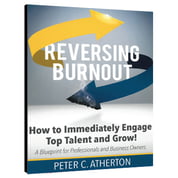Most architecture and engineering firms leave a lot of money on the table with our lack of focus and effectiveness in talent training and development.
When we think of improving, we generally turn to traditional project management training. It makes sense. We need it, it’s what we were taught, and it’s safe to advocate for – but it will only get us so far.
If we are looking for greater growth and profits in this new era, we need more than a good “playbook.” We need better equipped players throughout our organization to call and execute the right plays at the right time and with the right people.
What gets us there is better talent investment, employee engagement, and leadership modeling – not just better contracting, monitoring, and invoicing.
Better Investment
We absolutely need better scope, schedule, and budget training but our largest gains, especially today, is with helping our people become better “people-people.”
There is no question that higher levels of success are associated with higher levels of awareness and emotional intelligence, which includes our ability to successfully manage ourselves and influence others.
In terms of baseline, the fact is that most of us are starting from a deficit in terms of “people skills,” and we already have significant exposure in terms of performance and employee engagement and retention given that:
-
The vast majority of our managers continue to be promoted based on their technical skills.
-
Employees most often leave managers, not organizations.
-
The relationship with one’s direct supervisor has a 70-percent variance on employee engagement (based on Gallup research).
One final point here on investment… we need a mindset shift.
The “Talent-Client” relationship is fundamental to our business. Without clients, we have no business. But without talent effectively serving those clients, we have no business either. And, increasingly, it’s becoming harder to find and retain great employees than it is clients.
Part of the reason we do better with clients today is the significant level of investment we’ve made over the past two decades. Great client service and experiences matter – and will continue to. However, our greatest opportunity today is to invest as much or more in talent development in order to drive even greater client service through better team engagement, innovation, and project delivery.
New Era Engagement
Employee engagement today is about relationships and alignment.
Employee engagement is an employee’s emotional connection to his or her firm, its leaders, and direct supervisor… and, more specifically, about their collective ability to align project, team, client, and organization goals with their individual personal and professional goals. In order to have success, talent needs to want to be on our teams.
Only through better people skills at all levels can we build the relationships needed to get there.
More Modeling
Learning to manage and lead “on the fly” or through “trial by fire” is not attractive or effective.
As leaders, we can’t accept the status quo or allow the continuance of processes, mindsets, and systems synonymous with how we “came up” decades ago. Such beliefs are barriers to engagement and limit influence.
Leadership’s actions and behaviors drive our organization’s culture and long-term success.
-
Are your actions and behaviors aligned with what’s needed for success today?
-
What about your peers and others throughout your organization?
It is critical as leaders that we make the time to continuously reflect, recalibrate, and redesign our approach as necessary.
Only by becoming our best-selves and modeling the behaviors needed for success will we be able to inspire others in our organization to both “think” and “act” like us.
5 Steps to Take
To begin to design and implement a better people and performance strategy, we can start with these five steps:
-
Shift to a talent-first (or at least a talent-equal) mindset. Without such a shift, your near-term performance and long-term engagement and retention efforts will be short-lived.
-
Redesign your “playbooks” – the standards and guidelines that define, teach, and share your organization’s distinct processes and approaches to project, talent, and client success. For most of us, our project execution and management manuals, as well as our employee performance and development systems need a major overhaul.
-
Invest in “essential skills” development and deployment throughout your firm. We always need to be investing in self, team, and organizational awareness; strategic systems design; and the increasingly high levels of emotional intelligence necessary engage, inspire, and align effort with results.
-
Insist and incentivize leaders to model the behaviors we want and need. There is a direct link between culture and performance, and a truly effective culture starts at the top.
-
Specifically incorporate “essential skills” training as part of your standardized project management, supervisor, and leadership development programs. It’s one of the key levers to improving overall employee engagement and team performance.
Part 2 of this series will focus on how we can leverage “mission” to further improve our success. You can also link here for more from Pete on PSMJ: Peter C Atherton and PSMJ.
About the Author: Peter C. Atherton, P.E. is an A/E/C industry insider having spent more than 24 years as a successful professional civil engineer, principal, major owner, and member of the board of directors for high-achieving firms.
Pete is now the President and Founder of ActionsProve, LLC (www.actionsprove.com), author of “Reversing Burnout. How to Immediately Engage Top Talent and Grow! A Blueprint for Professionals and Business Owners”, and the creator of the I.M.P.A.C.T. process.
Pete is also host of The AEC Leadership Today Podcast (https://actionsprove.com/podcast/). Pete works with A/E/C firms to grow and advance their success through better strategic planning, executive coaching, leadership and management development, performance-based employee engagement, and corporate impact design. Connect with him at pete@actionsprove.com.
 Reversing Burnout. How to Immediately Engage Top Talent and Grow! A Blueprint for Professionals and Business Owners uses a thorough and easy-to-follow approach, that only an engineer can provide. Peter Atherton presents the promise and the opportunities of the new professional and organizational landscape. As engineering is the practical application of science, Reversing Burnout is the practical application of the new era we’re in to reverse professional and executive burnout, improve employee engagement, and grow.
Reversing Burnout. How to Immediately Engage Top Talent and Grow! A Blueprint for Professionals and Business Owners uses a thorough and easy-to-follow approach, that only an engineer can provide. Peter Atherton presents the promise and the opportunities of the new professional and organizational landscape. As engineering is the practical application of science, Reversing Burnout is the practical application of the new era we’re in to reverse professional and executive burnout, improve employee engagement, and grow.
You also might be interested in these posts by Peter C. Atherton, P.E: The New Rules of Employee Engagement – Part 1: Know Your RoleThe New Rules of Employee Engagement – Part 2: Doing Our Job as LeadersThe New Rules of Employee Engagement – Part 3: Doing Our Job as ManagersThe New Rules for Employee Engagement – Part 4: Doing Our Job as Employees




